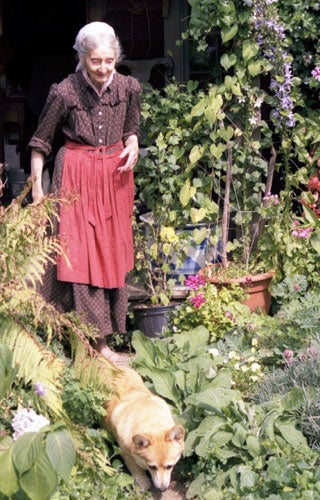Tasha Tudor: Children's writer and illustrator

Tasha Tudor was the illustrator of nearly 100 children's books. The rural settings of the past were a constant inspiration in her artistic work and eventually led to her living the life of a 19th-century farmer herself. When not writing or painting, she spun and wove flax into cloth, sewed her own long dresses, milked her Nubian goats and worked barefoot in her teeming vegetable and flower gardens. In time this well-publicised lifestyle turned her into something of an icon of alternative living.
She was born Starling Burgess, the daughter of William Starling Burgess, a noted aeroplane, car and yacht designer, and Rosamond Tudor, a successful portrait painter. She was soon nicknamed Tasha by her father, after Natasha in War and Peace, and in later life changed her surname to Tudor. Growing up in Boston, she disliked boarding-school life, preferring to draw, read and look at picture books, particularly those by Kate Greenaway and Beatrix Potter. Both of these artists had a great influence on her development as an illustrator.
After her parents divorced, the nine-year-old Tasha went to live during the week with family friends in Redding, Connecticut. She learned to dance and act, but best of all had the chance to fall utterly in love with country living, soon scraping enough funds together to buy her own cow and chickens.
Studying at Boston Museum Fine Arts School, Tasha started writing and illustrating her own books, with Pumpkin Moonshine (1938) appearing to excellent reviews after many rejections. Still in print, it tells the story of a young girl's attempts to make a jack-o'-lantern from a pumpkin that insists on running away. In the same year she married Thomas McReady, a fellow resident in Redding but at heart a city-dweller.
Undaunted, Tasha moved them both into her mother's farm, where Thomas sold milk, eggs and butter while she looked after the cows, geese, ducks and hens. Starting a family, she yearned for an even more remote life, eventually settling for a neglected 1740 farmhouse in Webster, New Hampshire, crammed with antique furnishings. Bread was home-baked and clothes washed by hand.
Happy to live without electricity and for the first five years with no running water, she brought up four children there while also producing quantities of well-received picture books. Alexander the Gander (1939) was one of many stories based on her own animals. Her greatest triumph was with Mother Goose: seventy-seven verses (1944). This often pictured her own children, the girls wearing long dresses and the boys knee breeches. Alternating soft watercolours with pen-and-ink drawings, this illustrated anthology scorned any darker reading of these little rhymes in favour of a pervading sense of serenity.
The old ladies cutting off mice tails or living in a shoe still seem roundly contented with their lot, with Humpty Dumpty only showing mild irritation when falling off his wall. A detailed panorama of buildings on the north bank of the Thames accompanying "London Bridge is falling down" is the only reference to urban living in what is otherwise a paean of love for the virtues of traditional country life seen at its most idyllic. Just the sort of escapism her American and British audiences were looking for during the war years, this collection was chosen as one of the Caldecott Honor books by the American Library Association in 1945.
Other successes included Edgar Allan Crow (1953), also named after a pet, plus illustrations for Fairy Tales from Hans Christian Andersen (1945), Stevenson's A Child's Garden of Verses (1947), Frances Hodgson Burnett's The Secret Garden (1962) and Kenneth Grahame's The Wind in the Willows (1966). From Tasha Tudor herself there was also Corgiville Fair (1971), an imaginative tale about some humanised corgi dogs, her favourite pets in real life where at one time she was the owner of 14. This story led to a number of sequels.
In 1989 she jointly set up the Jenny Wren Press, much of it devoted to the distribution of her many Christmas and Valentine cards. There were also occasional oil paintings plus specially designed dolls, marionettes and tiny pieces of doll's-house furniture.
In 1961 Tasha divorced Thomas, with a later marriage to Allan John Woods lasting only a brief time. Her new freedom meant that she could move to Marlboro, Vermont, buying land next to the house owned by her son Seth. Using only hand-tools, Seth then built his mother a model 19th-century New England farmhouse where she lived for the rest of her life. Spurning electricity, making her own cheese and butter and walking barefoot in her 1830-designed clothes, Tudor continued to write and illustrate, producing her last book, Corgiville Christmas, in 2003.
One of her last wishes was that she be reborn in the 1800s, and become the wife of a sea captain.
Nicholas Tucker
Starling Burgess (Tasha Tudor), children's illustrator and writer: born Boston, Massachusetts 28 August 1915; married first 1938 Thomas McReady (deceased; two sons, two daughters), secondly Allan John Woods; died Marlboro, Vermont 18 June 2008.
Subscribe to Independent Premium to bookmark this article
Want to bookmark your favourite articles and stories to read or reference later? Start your Independent Premium subscription today.

Join our commenting forum
Join thought-provoking conversations, follow other Independent readers and see their replies